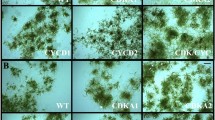Summary
Dictyostelium mucoroides-7 (Dm 7) and a mutant MF 1 derived from it exhibit two developmental pathways: sorocarp formation occurs during the asexual process, and macrocyst formation during the sexual cycle. The two developmental pathways are mainly regulated by two chemical substances: 3′,5′-cyclic adenosine monophosphate (cAMP) and ethylene. Recently, we have demonstrated that cytoplasmic pH (pHi) has a critical role for the choice of developmental pathways, higher pHi being favourable to macrocyst formation. Thereupon, attention was riveted to the relation of pHi to biosynthesis of cAMP and ethylene. Effect of pHi on the production and release of ethylene, a potent inducer of macrocyst formation, was examined, using the two facing culture method. The result showed that lowered pHi inhibits ethylene production, thus resulting in a failure of cells to form macrocysts. The accumulation of cAMP, an inhibitor of macrocyst formation, was found to vary depending on extracellular pH (pHo), but diethylstilbestrol (DES) that is a proton pump inhibitor and also an inhibitor of macrocyst formation had no significant effect on the accumulation. Taken together these results indicate that higher pHi may induce macrocyst formation through enhancement of ethylene production rather than inhibition of cAMP synthesis.
Similar content being viewed by others
Abbreviations
- cAMP:
-
3′,5′-cyclic adenosine monophosphate
- pHi :
-
cytoplasmic pH
- pHo :
-
extracellular pH
- ACC:
-
1-1-aminocyclopropane-1-carboxylic acid
References
Abe T, Maeda Y (1986) Induction of macrocyst germination in the cellular slime mouldDictyostelium mucoroides. J Gen Microbiol 132: 2787–2791
Aerts RJ, Durston AJ, Moolenaar WH (1985) Cytoplasmic pH and the regulation of theDictyostelium cell cycle. Cell 43: 653–657
Amagai A (1984) Induction by ethylene of macrocyst formation in the cellular slime mouldDictyostelium mucoroides. J Gen Microbiol 130: 2961–2965
— (1987) Regulation of the developmental modes inDictyostelium mucoroides by cAMP and ethylene. Differentiation 36: 111–115
— (1989) Induction of zygote formation by ethylene during the sexual development of the cellular slime moldDictyostelium mucoroides. Differentiation 41: 176–183
—, Filosa MF (1984) The possible involvement of cyclic AMP and volatile substance(s) in the development of a macrocyst-forming strain ofDicytostelium mucoroides. Devel Growth Differ 26: 583–589
Bonner JT (1947) Evidence for the formation of cell aggregates by chemotaxis in the development of the slime moldDictyostelium discoideum. J Exp Zool 106: 1–26
Erdos GW, Nickerson AW, Raper KB (1973) The fine structure of macrocyst germination inDictyostelium mucoroides. Dev Biol 32: 321–330
Filosa MF (1979) Macrocyst formation in the cellular slime moldDictyostelium mucoroides: involvement of light and volatile morphogenetic substance(s). J Exp Zool 207: 491–495
—, Dengler RE (1972) Ultrastructure of macrocyst formation in the cellular slime mold,Dictyostelium mucoroides. Dev Biol 29: 1–16
Hames BD, Ashworth JM (1974) The metabolism of macromolecules during the differentiation of myxamoebae of the cellular slime mouldDicytostelium discoideum containing different amounts of glycogen. Biochem J 142: 301–315
Iijima N, Maeda Y (1990) The influence of pH on the choice between sexual and asexual development inDictyostelium mucoroides. J Gen Microbiol 136: 1739–1745
Inouye K (1988) Differences in cytoplasmic pH and the sensitivity to acid load between prespore cells and prestalk cells ofDictyostelium. J Cell Sci 91: 109–115
John P (1983) The coupling of ethylene biosynthesis to a transmembrane, electrogenic proton flux. FEBS Lett 152: 141–143
Nickerson AW, Raper KB (1973) Macrocysts in the life cycle of the Dictyosteliaceae. II. Germination of the macrocysts. Amer J Bot 60: 190–197
Schindler J, Sussman M (1977) Ammonia determines the choice of morphogenetic pathways inDictyostelium discoideum. J Mol Biol 116: 161–169
Sussman M, Schindler J (1978) A possible mechanism of morphogenetic regulation inDictyostelium discoideum. Differentiation 10: 1–6
Van Duijn B, Vogelzang SA (1989) The membrane potential of the cellular slime moldDictyostelium discoideum is mainly generated by an electrogenic proton pump. Biochim Biophys Acta 983: 186–192
Weinkauff AM, Filosa MF (1965) Factors involved in the formation of macrocysts by the cellular slime mold,Dictyostelium mucoroides. Can J Microbiol 11: 385–387
White GJ, Sussman M (1961) Metabolism of major cell constituents during slime mold morphogenesis. Biochim Biophys Acta 53: 285–293
Williams GB, Elder EM, Sussman M (1984) Modulation of the cAMP relay inDictyostelium discoideum by ammonia and other metabolites: possible morphogenetic consequences. Dev Biol 105: 377–388
Yu YB, Adams DO, Yang SF (1979) 1-aminocyclopropane carboxylate synthase, a key enzyme in ethylene biosynthesis. Arch Biochem Biophys 198: 280–286
Author information
Authors and Affiliations
Rights and permissions
About this article
Cite this article
Iijima, N., Amagai, A. & Maeda, Y. Involvement of cytoplasmic pH in the production of ethylene, a potent inducer of sexual development inDictyostelium mucoroides . Protoplasma 160, 72–76 (1991). https://doi.org/10.1007/BF01539958
Received:
Accepted:
Issue Date:
DOI: https://doi.org/10.1007/BF01539958




